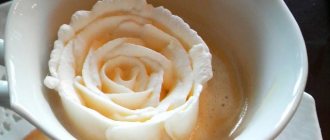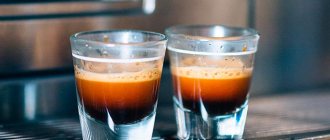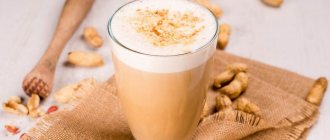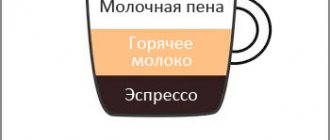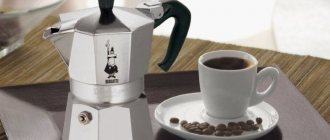Mixing espresso or Americano with additional ingredients allows you to get latte, cappuccino, frappe, raff, etc. One of the most popular types of coffee is iced coffee. It is prepared on the basis of Americano and ice cream, but milk, cream, spices, etc. are often added to enrich the taste.
Iced coffee is a chilled drink with the addition of ice cream.
How to choose ingredients for glaze?
To prepare the drink, you must take bottled or spring water so as not to spoil the unusual taste of the drink. The mineralization level should be 150 mg/l. Slight deviations up or down are possible.
As for coffee, it is best to stock up on a mixture of Arabica and ten percent Robusta. Ground coffee that has slightly lost its aroma will also work. As for roasting, medium is best. This way the finished drink will taste pleasant and less bitter. Coffee is prepared both in a coffee machine and in a Turk. If a Turk is used, the drink is filtered. There should be no small particles in the finished drink.
It would seem that you can choose any ice cream for iced coffee. But the drink will be tastier if you add creamy ice cream to it. To obtain an original taste, use creme brulee or chocolate ice cream.
Classic iced glass recipe
To prepare two servings of cocktail you will need:
- freshly brewed coffee - 300 ml;
- ice cream or ice cream - 100 g.
It is also necessary to prepare in advance special molds for cutting out ice cream balls, drinking straws, coffee spoons, napkins or cup holders, canonical glasses or wine glasses in which the drink will be served.
You might be interested in Honey Raf coffee
Cooking method:
- Brew coffee using an iced machine or French press.
- Strain the hot drink and carefully pour into a prepared serving bowl.
- Cool the ice cream, cut out the balls.
- Place ice cream in glasses with coffee.
Thick drinking straws are inserted into the cups, which are recommended to be rinsed in advance with cold water. The glasses themselves are placed on napkins or cup holders, and a coffee spoon is included. This is the culture of serving ice cream.
Instead of ground coffee, the recipe allows the use of instant coffee, which, of course, is inferior in taste and aroma to the natural product.
Secrets of making a coffee drink
If we take the classic version, then its temperature should be plus ten degrees. It’s just that after such a drink in the heat your throat will hurt. It is better to cool the coffee to a temperature of plus twenty. In autumn or winter, the drink should be no colder than thirty degrees. The hotter the coffee, the faster the ice cream melts in it. This should be taken into account. The main thing to remember is that tooth enamel suffers from strong temperature changes.
The coffee is brewed in advance so that it has time to cool. Usually twenty to forty minutes before actual cooking. Hot coffee is not placed directly in the refrigerator, but placed, for example, in a saucepan with cold water. The water can be changed after five to ten minutes. This will allow the coffee to cool faster.
Glace is prepared in two different ways:
- Ice cream is placed on the bottom, then coffee is added. The ice cream will float to the surface and the coffee will turn beige.
- First, coffee is poured, and a scoop of delicious ice cream is placed on top. It looks very impressive.
Ice cream is added immediately before serving, not earlier, otherwise it will melt.
White glass
This method of preparing ice cream has a refined taste. To prepare it, it is better to take strong roasted coffee.
Ingredients:
- coffee (maximum strength) - 200 ml;
- medium fat milk - 200 ml;
- ice cream - 100 g;
- sugar to taste.
How to cook:
- Brew coffee.
- Cool the hot drink and mix it with cold milk (1:1 ratio).
- Pour coffee into containers and top with scoops of ice cream.
White iced glass is great for cooling on a hot summer day!
Iced coffee at home
Now let's try to prepare a classic glaze.
- We brew 120–150 ml of black coffee in a Turkish coffee pot or use a coffee machine. Add sugar if desired.
- Filter and cool. Temperature from ten to thirty degrees.
- Pour coffee into a glass, add a scoop of ice cream (50 g).
To taste, sprinkle the drink with grated chocolate, coconut or cinnamon. It all depends on preference.
What is the difference between iced glass and latte?
These two coffee drinks are often confused, but experienced coffee lovers understand perfectly well the difference between a glass and a latte. Both of these cocktails have a milder taste compared to traditional coffee, are prepared on the basis of double espresso, contain less caffeine and are more gentle on the body, but the ingredients included in the recipes are different. Latte means “milk” in Italian, and the main component that influences the taste of a coffee cocktail is this product. To prepare the drink, you need a coffee maker equipped with a device that whips milk into strong foam, the ratio to coffee is 2:6. Sugar is added to the composition to taste.
You may be interested in How to brew coffee in a saucepan on the stove - proven recipes
To prepare the ice cream, as mentioned earlier, use a recipe with ice cream (2 scoops).
By the way, there are often cases when ice cream is confused with Irish coffee, but the latter’s recipe includes whipped cream and strong Irish whiskey.
Cooking "Affogato"
Affogato is an Italian dessert that is very similar to glace. The name of the dessert translates as “drowned man”. Considered very fashionable in Europe.
- Take a martini glass, turn it over and hold it over the steam. You can also use a kettle.
- Sprinkle the inner walls of the glass with grated chocolate.
- Using topping we draw patterns on the walls.
- Pour 10–20 ml of liqueur or syrup. Taste – almond, vanilla, chocolate.
- Spread 50 grams of ice cream.
- Prepare espresso (30–60 ml) and add to the glass.
- Sprinkle dark chocolate on top.
Calorie content of the drink
All those who care about their figure should be careful - iced coffee has quite a high calorie content, because it contains a portion of ice cream. So if you are afraid of gaining weight, opt for other coffee drinks - with or without the addition of milk.
However, if you cannot resist the taste and aroma of iced coffee, keep in mind that the calorie content of a cup of iced coffee prepared according to the classic recipe will be 110 kcal. Adding toppings, as well as sprinkles of nuts or chocolate will make the drink even more nutritious - such a serving will already contain 150-170 kcal.
It’s worth considering how many calories are contained in these cocktails, prepared according to the standards of popular chain coffee shops:
- As for iced coffee from McDonald's, its calorie content will be 125 kcal.
- Glaze in coffee shops of the Shokoladnitsa chain - 186 kcal.
On a note! But you won’t be able to taste ice cream at your favorite Starbucks - there is no such item on the menu of these chain coffee shops. But it has many worthy analogues.
How to serve and drink ice?
Since glace is to some extent considered a dessert, it is poured into a tall glass glass, for example, for Irish coffee, with a straw and a spoon. If you decide to add alcohol to the glass, then it is better to take a glass for short drinks; a short straw is required.
The drink is drunk, stirring with a straw. Or they eat ice cream with a spoon first, and then drink coffee. By the way, ice cream is not considered invigorating, since ice cream weakens the effect of caffeine. You can enjoy it in the evening too. Sweets are not served.
Iced coffee recipes
There are many ways to prepare iced coffee, some of which have become canons for bartenders and baristas.
Classic iced coffee
What will you need?
- A serving of espresso or Americano is 90 ml.
- Ice cream – 1 part to 3 parts coffee from the volume of the drink. If you take 90 ml of coffee, then you will need 30 grams of ice cream. If you decide to limit yourself to a small portion of espresso of 30 ml, then take 10 grams of ice cream.
- If you need to sweeten your coffee, add sugar, honey or syrup to the hot drink to dissolve.
How to cook?
- Let the coffee cool down well. The drink should have a temperature of approximately 10-15 degrees.
- Pour cold coffee into a glass goblet or narrow cup and carefully place a scoop of ice cream on top.
- Decorate with chocolate shavings, topping, and almond flakes.
Iced coffee with egg yolks
What will you need?
- Coffee brewed at the rate of 10 g. powder per 150 ml of water. A serving of Americano is also suitable for the recipe.
- Powdered sugar - 3 tablespoons (can be replaced with 1.5 tablespoons of sugar).
- Egg yolks 2 eggs.
- Ice cream – 40 gr.
- Topping – caramel or chocolate – 10 g.
How to cook?
- Brew and cool coffee. It is enough that it is just warm, not hot.
- Separate the yolks from the whites.
- Grind the yolks with sugar or powder until white.
- While stirring, pour coffee into the yolk mixture.
- Place the mixture in a water bath.
- Stirring, cook for about 12-15 minutes until the mixture thickens.
- Remove from heat and pour the finished mixture into a tall glass.
- Cool to room temperature.
- Place ice cream on top.
- Drizzle with topping. You can steal nuts.
Iced coffee with cream
What will you need?
- A serving of espresso coffee or strong coffee brewed in a cezve – 100 ml.
- Ice cream – 50 gr.
- Whipping cream (at least 33% fat) – 3 tbsp. spoons.
- Topping – caramel, chocolate, berry – 1 tbsp. spoon.
- Chocolate or nut chips - 1 teaspoon.
- Finely crushed ice - 1 tbsp. spoon.
How to cook?
- Brew coffee, cool to 10-15 degrees.
- Place ice at the bottom of a glass and tall cup and place ice cream on it.
- Gently pour coffee down the side of the cup.
- Place whipped cream on top.
- Drizzle with topping and sprinkle with chocolate or nut crumbs.
Iced coffee cocktail (for persons over 18 years old)
The recipe for glaze without ice cream, but with alcohol makes it closer to cocktails.
What will you need?
- Chilled coffee (espresso or brewed in a cezve) – 50 ml.
- Liqueur (cream, orange or apricot) – 25 ml.
- Syrup – 1 tbsp. spoon.
- Finely crushed ice - 2 teaspoons.
How to cook?
- Place ice at the bottom of the glass.
- Pour syrup on top.
- Pour chilled coffee into a cup.
- Add alcohol.
A coffee-glazed cocktail can also be prepared with ice cream, putting it on ice instead of syrup. In this case, it is better to prefer a creamy liqueur - Baileys or Irish Cream.
Glass with alcohol
Liqueur will make the glace piquant and aromatic. Strong drinks: whiskey, rum, cognac are not used because they absorb the taste of coffee.
Cream, chocolate, coffee, orange and coconut liqueur are perfect. Pour 30 grams of alcohol into a serving of glace; you can omit the additives or use them to match. For example, grated chocolate or marzipan, orange zest, coconut flakes. Do not add ice, it waters the composition and makes it expressionless.
Iced coffee is a great way to refresh and invigorate on a hot day. It is easy to prepare at home and on vacation, and enjoy its delicate and slightly tart taste while sipping leisurely.
How to drink iced glass
It is correct to drink coffee with ice cream without stirring. Initially, the ice cream is eaten with a spoon, and then the coffee drink itself is drunk through a straw.
It is customary to consume ice cream between main meals. The cocktail is not strong.
Therefore, the drink can be drunk even in the afternoon. By adding ice cream, the effect of caffeine is partially neutralized.
Glace is a delicious cocktail that can refresh you on a hot summer day and at the same time quench your appetite. There are many recipes for its preparation. It is worth trying each of them to choose the most suitable one for yourself. The main thing is to strictly observe the indicated proportions and carry out all actions step by step. Moreover, the result, without any doubt, will exceed all expectations.
History of Glace
It is believed that the glace recipe was born in Austria: at the end of the 19th or beginning of the 20th century. It so happened that one of the capital’s coffee shops ran out of cream, and the visitor was served Viennese coffee with ice cream. The guest liked the drink so much that from then on he ordered only this type of coffee. Be that as it may, in the 20th century, when technology made it possible to make ice cream cheaper, ice cream became very popular all over the world.
There were some difficulties with writing this word in Russian. Linguists have long argued about the correct name for the drink: glace or glasse. For some time, spelling dictionaries allowed both spellings, but in recent editions the “glase” option is recognized as correct.
Paradise Coffee
This option is a real paradise for gourmets!
- coffee - 250 ml:
- ice cream or ice cream - 100 g,
- whipped cream - 2 tablespoons (you can use the finished product),
- chocolate syrup - 2 tablespoons,
- caramel candies or crumbs - 2 teaspoons,
- sugar - 2 tablespoons,
- finely ground cocoa - optional.
How to prepare Paradise glasse:
- Brew espresso, cool. The approximate temperature of the drink should be less than 15 degrees.
- Grind powder from sweet sand and mix with whipped cream.
- Mix sweet powder with cooled whipped cream. The cream should be strong and not run off the spoon.
- Pour chocolate syrup into the bottom of the glasses and pour coffee on top.
- Decorate the drink with whipped cream, cocoa, and ice cream balls.
The finishing touch is to decorate the frosting with candy crumbs. Drink immediately and enjoy the multifaceted range of taste and smell of the drink.
Geography and spelling
For the first time, coffee with ice cream was prepared in the very center of Europe, in the country of snow-capped Alpine peaks. It happened in one of the many coffee shops in Austria and, as often happens in the history of coffee, “His Majesty Chance” intervened. The savvy bartender replaced the milk that was missing for making cappuccino with ice cream. And in vain he was worried that a regular visitor to the establishment would be offended by the catch! The client appreciated the employee’s ingenuity and began ordering coffee only in the updated version.
Successful culinary discoveries spread quickly. It's a stone's throw from Austria to France, and the French hastened to join the original invention. Considering the “coldness” and aristocracy of the coffee drink, they called it coffee glace. Translated from French, glacé means “icy”; in another interpretation, “chilled”. At first, only noble people enjoyed it in salons and restaurants while engaging in small talk.
Glyase soon gained recognition among the people. The common people liked its name, as did the taste of the new coffee cocktail. The name glace is forever associated with the duo of iced coffee and ice cream.
The issue of stress in the word was not raised: since its origin is French, that means the emphasis is on the last syllable. Linguists are unanimous about the number of “s” in a word. Despite the French spelling with one letter “s”, the use of the term “glasse” is acceptable.
Note: the name of the drink “glissé” is erroneous. Here I would like to add the letter “r” at the end of the word and continue to think in a different direction: about high-speed small vessels and high-speed boats.
Cooking secrets
The process of preparing glace has several important nuances:
- For a summer dessert, take completely chilled coffee, and for a winter dessert, warm coffee. In the first case, the temperature of the finished drink is +10...+20°C, and in the second - +30...+32°C.
- When adding whipped cream, do not mix it with hot coffee. High temperatures and acidified environments can cause the product to curdle. A cap of whipped cream is carefully placed on a warm coffee base or on top of ice cream.
- It is recommended to add spices (vanilla, cloves, ginger) to the base during the cooking process. Cinnamon is suitable both for enriching the aroma and for decorating the dessert. To give Americano an unusual flavor, you can add dried figs or cardamom to the cezve.
- If you use sweetened cream (for example, from a can), you can do without adding sugar or honey.
- To obtain a rich taste, you can mix several types of topping. Recommended combinations: chocolate-cherry, vanilla-berries, coconut-pineapple, mint-lemon.
General information about the drink
Even the most loyal fan of hot, strong coffee in hot weather will probably not get much pleasure from his favorite drink. On such a day, you want something cooler and refreshing, but at the same time invigorating. It was probably on one of these days, in search of coolness, that one of the resourceful coffee lovers had the idea to combine coffee with ice cream.
Coffee with ice cream is called iced. This name comes from the French word “glace”, which means “icy”. So that every time you order this drink, you are not afraid to name it incorrectly, you definitely need to find out and remember where the emphasis falls in the word glasse.
The classic version of ice cream is coffee with ice cream, but it can be replaced with any other ice cream: fruit, berry or chocolate. In addition to the ingredient from the freezer, “ice coffee” can include various liqueurs, syrups, spices and toppings. Despite the fact that it is most often served chilled, it is no less good hot. It all depends on personal preference.
While enjoying another glass of a refreshing drink, do not forget that it has a fairly high calorie content. So, one serving of classic coffee with ice cream contains about 150 kcal. And the additional ingredients included in its composition can increase the calorie content of the drink by 2-3 times.
How to write correctly and put emphasis on the word “glaze”
In the word "glace" the stress is placed on the last syllable, because this structural unit is of French origin, and among the French the last vowel sound is always stressed, as it should, it will be correct to say glasse.
Glasse or glasse? Which spelling of this word is correct? Focusing on the complete edition of the spelling dictionary, the last option is considered correct. In addition, the French word “glace” has one letter “c”. It entered the Russian language in a constant word form. But on Wikipedia you can find other information, according to which option 1 is also acceptable.
So, both forms are correct; by writing both “glyse” and “glace”, a person will not make a spelling mistake.
The most complete guide to types of coffee: from variety and roasting to recipes
Do you order a standard cappuccino so as not to waste time and not have to sort through the endless coffee list? Do you buy “just grains” and are constantly upset that you still don’t get the desired taste? Do you think that coffee only comes in beans, ground and instant? Experts will help you understand the classification of coffee and how to prepare it. After reading this article, you will definitely find coffee that you like and learn how to prepare it correctly.
Where does the coffee bean come from?
Let's start from the beginning. In nature, there are more than 90 species of plants of the genus Coffea, but four species are specially grown, and only two of them are used on an industrial scale.
Arabica
The most popular type of coffee with many man-made varieties. Arabica is a coffee classic with a rich, interesting taste, natural sourness and sweetness. However, Arabica itself is not very rich in caffeine (1-2% of the total chemical composition), so it is often mixed with Robusta.
The name "Arabica" has a geographical origin - people began to grow this type of coffee on the Arabian Peninsula in the 14th century.
Robusta
Not as good in taste as Arabica and has a characteristic bitterness. But Robusta is very tonic: it has 2 times more caffeine than its famous sister. This type of coffee is also good for its endurance: where delicate Arabica dies from temperature changes and diseases, Robusta easily bears fruit. In general, if you are looking for a truly strong coffee, then either pure Robusta or a mixture of Arabica and Robusta, with at least 30% Arabica and Robusta content, will suit you.
Liberica
Many people have heard about Liberica, but few have seen it, although in the coffee world it is considered potentially very interesting. The main advantage of Liberica is its amazing aroma, for which it is grown: essences from Liberian coffee are loved by the confectionery industry. But, for example, in Malaysia, it is more popular than Arabica and Robusta combined.
Excelsa
An even rarer coffee tree, grown in Africa and Southeast Asia. They both love and dislike it at the same time for its fruity and slightly “perfumy” taste with sourness. It is almost impossible to find Excelsa in its pure form in stores, but it is sometimes found in mixtures with Arabica.
Popular coffee varieties
There are about a thousand cultivated varieties of coffee, but they are all subspecies of Arabica and Robusta, or their hybrids. The most common are several subspecies of Arabica, which, when grown in different conditions, often give completely different tastes.
Coffee beans LavAzza “Qualita Oro”, 500 g 752 rub.
Lavazza “Qualita Oro” coffee beans, 250 g 351 rub.
Compagnia Dell'arabica "Jamaica Blue Mountain" bean coffee, 1500 g 48,960 rub.
Coffee beans Paretto “Celesto”, freshly roasted, 1000 g 1619 rub.
Coffee beans Jockey “Traditional”, 100 g 71 rub.
Bean coffee Bushido “Red Katana”, 1000 g 1921 rub.
Coffee beans Lavazza “Qualita Oro”, 1000 g 1550 rub.
Coffee beans Lavazza “Gran Crema Espresso Barista”, 1000 g 1400 rub.
Coffee beans Black card, 1000 g 765 rub.
Coffee beans Lebo “Original”, 100 g 79 rub.
View all coffee beans
- Typika
It is a difficult and fastidious variety of coffee to cultivate, but with proper care it gives the best results. Among the Arabica Typica varieties are the “elite” of the coffee world: Jamaica Blue Mountain, Guatemala, Pluma Hidalgo, Sumatra, Kent, Java, etc.
The main feature of typika: natural sweetness and lack of bitterness.
- Bourbon
A natural mutation of Typica with a rich fruity flavor and complex acidity. The most famous varieties of bourbon: Ibairi, Jackson, Arusha, Yellow, Red, Orange, Pink Bourbons.
- Mocha
One of the most ancient types of Arabica, not bred by man, but formed thanks to nature. Mocha has small beans that, when roasted, produce a rich flavor with spicy notes and a slight heat.
- Maragogyp
Maragogype originated from the usual typica. The main difference of this variety is the huge grains, which are almost 3.5 times larger in size than Typica grains. Maragojipe always has a slight chocolate note in its taste.
Single-origin and blended coffees
All coffee presented in stores is divided into single varieties and blends. The advantage of single varieties is that you can feel the peculiar taste of each individual variety and select your favorite one. The advantage of blending is to harmoniously emphasize the positive properties of each component of the blend and create a product of stable quality.
Types of coffee by processing method
Despite the fact that the final buyer may find out the method of processing coffee cherries in quite rare cases, the processing greatly affects the final taste of the drink.
Dry (natural)
processing is more often used to reduce the cost of the process. With it, the berries are simply dried in the sun on a concrete or brick surface until they turn into something like raisins. After this, the outer layers are peeled off and the grain is sold. Correctly carried out processing gives the taste of coffee sweet shades of berries and fruits. Wrong – earthy taste.
Washed
processing means that the grains are removed from the berries using special equipment, but are not cleared of the sticky shell. In this form, they are placed in fermentation tanks for 1-2 days, and then washed with clean water and dried. Almost all specialty coffee is processed this way.
Honey (semi-washed processing)
– the result of technologists’ experiments. The process works differently in different countries. The difference with washed one is that less water is spent on processing. The finished drink has more sweetness in its taste.
Types of coffee by roasting method
The taste of finished coffee is a combination of natural data (variety and growing conditions) and roasting.
There are quite a few varieties of coffee according to the roasting method. In different sources you can find French, Italian, American, Viennese, but by and large, all types of roasting can be divided into 3 categories.
- Light
Light roasting is called roasting until the first crack (cod). These grains are light brown in color and there are no traces of oils on their surface. Light roasting is good because it most carefully preserves the natural taste of the grain with fruity notes and sourness. True, there is also a minus: if the grain is not initially the best, such roasting will highlight all the shortcomings. Best for alternatives: Chemex, pour over, French press.
Types of light roasts: cinnamon, light, New England, etc.
- Average
Universal roasting at temperatures from 210 to 225 degrees. The beans are chocolate colored, still free of oil stains on the surface. Medium roast is ideal for lovers of the classic taste of coffee. These grains can be prepared in any way.
Types of medium roast: American, city, full city, etc.
- Dark
Roasting at a temperature of 230 to 250 degrees. It is good because it hides the shortcomings of the original grain. It is bad because it does not allow the natural taste of coffee to reveal itself and is, by and large, only suitable for espresso.
Types of dark roast: French, Italian, Spanish.
Types of coffee by grinding degree
Different grinds are suitable for different methods of preparing coffee. The basic rule: the finer the fraction, the faster the coffee extraction will occur.
Ground coffee Lavazza “Crema e Gusto”, 250 g 258 rub.
Ground coffee Lavazza “Qualita Oro”, in a tin can, 250 g 400 rub.
Ground coffee Coffesso “Classico Italiano”, 5 sachets -25%
110 rub. 146 rub.
Ground coffee Jardin “Espresso di Milano”, 250 g 221 rub.
Ground coffee Lebo “Extra”, for Turkish, 75 g 61 rub.
Ground coffee Living Coffee “Espresso”, 200 g 172 rub.
Ground coffee Jockey “Eastern style”, 450 g 334 rub.
Ground coffee Fresco Arabica Barista, for brewing in a cup, 100 g -50%
90 rub. 179 rub.
Ground coffee Jockey “For Turki”, 100 g 66 rub.
Ground coffee Aroma “Arabica for Turks”, 100 g 65 rub.
View all ground coffee
The finest grinding “to dust” is for a cup into which hot water has been poured.
For the cezve, fine grinding is also used, but the feel is similar to particles of sea sand.
Medium grind is used for geyser coffee makers and coffee machines.
Coarse grind – for French press.
Coffee Brewing Methods
Actually, all methods of brewing coffee are divided into 2 main types: preparation in a coffee machine (espresso and all its derivatives) and alternative. Let's talk about them in more detail.
Espresso and its derivatives
Since the invention of the first coffee machine and the creation of the espresso recipe, the coffee world has changed. Engineer Luigi Bezzera, who invented the espresso machine in 1901, had no idea that a century later his brainchild would live in every coffee shop in the world.
Espresso
- a drink that is obtained by passing hot water through a filter with ground coffee under high pressure. In the classic recipe for 30 ml. water required 7 g of coffee. The resulting strong, aromatic and dense coffee can be used as a base for other recipes.
Americano
– espresso, to which 90 ml is added. hot water.
We wrote more about the rules for preparing Americano here>>
Lungo
- also a type of espresso. But at the same time, more water passes through a standard “tablet” with ground coffee. The extraction process also takes longer, so the coffee comes out with a slight bitterness.
Ristretto
- a type of thick and rich espresso, in which 15-20 ml are used for a standard 7 g of coffee. water.
Cappuccino
– espresso, with the addition of milk, whipped into a smooth, beautiful foam. In this case, milk whipped by a cappuccino maker is added to coffee. If you don't have a cappuccino maker at home, you can froth milk using a regular French press.
See how to do it correctly:
Latte
- espresso with milk. In this case, unlike cappuccino, coffee is added to the milk.
Raf
- coffee, invented in Moscow and received its name in honor of a client of one of the capital's coffee shops - Raphael. In addition to the same espresso, it contains liquid cream and sugar (often replaced with syrups). Video recipe for lavender raffa with coconut milk.
Read the history of the appearance of raf here>>
And be sure to try this lavender raf with coconut milk from our tester Natalia Prokhorenko
Macchiato
- espresso with milk, and the milk is not poured in, but put in with a spoon to form a circle with a coffee rim.
Affogato and glasse
– espresso with ice cream. In the first case, a scoop of ice cream is poured over coffee, and in the second, ice cream is added to the coffee.
There are other recipes for coffee with ice cream>>
Kon-panna
– espresso with a cap of whipped cream. It looks like Viennese coffee is also made.
Alternative methods of making coffee
Alternative (or slow-coffee, “slow coffee”) - all methods of making coffee, except for a coffee machine.
Copper pot “Dream”, 330 ml. 1180 rub.
Coffee grinder Hot Contents “Zambezia” RUR 3,678
Coffee grinder “Columbia retro” RUB 2,458.
Geyser coffee maker Morosina, green (for 6 cups) RUB 1,570.
Chemex coffee maker Samadoyo FT-003, volume 700 ml 2000 rub.
Geyser coffee maker Morosina, red (for 9 cups) RUB 2,205.
Filter Clean Cup “Coffee funnel No. 2”, for preparing 1-4 cups of coffee, 1 piece 621 rub.
Filter Clean Cup “Coffee funnel No. 1”, for preparing 1-2 cups of coffee, 1 piece 552 rub.
Filter Clean Cup “Coffee Cones No. 2”, for 1-4 cups, 25 pieces 207 rub.
Geyser coffee maker Morosina, orange (for 3 cups) 970 rub.
View all coffee making accessories
Cezve
– a traditional vessel for making coffee, known since the times of the Ottoman Empire.
He came to Russia during the Russian-Turkish wars and received the name “Turk”. It’s easy to brew coffee in a cezve, it’s inexpensive and suitable for anyone. We wrote more about how to choose a Turk here>>
French press
– a popular device for brewing coffee, and an ideal find for the lazy, as well as Specialty lovers.
You can read how to choose a French press and brew really delicious coffee in it here >>
And in this video, our expert Vyacheslav Poschishchailo prepares exemplary coffee in a French press and shares unobvious secrets:
Geyser coffee maker (moka)
– the most popular coffee maker in Italy.
Inventor Alfonso Bialetti claimed that he had found a way to make espresso in any kitchen, but coffee prepared in a moka would still be different from that brewed in a coffee machine. Read more in this article>>
Chemex
- almost a chemical laboratory in the kitchen. A Chemex is a glass container with a funnel, shaped like a watch. It is considered the best option for making specialty coffee because it allows the natural taste to reveal itself.
Purover
– a compact funnel cup that comes complete with disposable or reusable filters. Spiral hot water through the ground coffee. The result is a drink with a soft and pleasant taste. See how it happens:
Cold brew
– both the name of the drink and the method of preparing coffee. It differs in that freshly ground coffee is poured with cold water and infused for 8 to 24 hours, depending on what taste and strength you want to get in the end. Read our material on how to brew cold brew correctly.
Recipes for making coffee drinks
All coffee recipes are divided into 2 types: hot and cold.
Hot coffee drinks
Espresso and all drinks based on it, coffee prepared in Turkish and other alternative methods, as well as coffee alcoholic cocktails, for example, Irish coffee, are served hot.
Each classic recipe has its own characteristics: from the choice of the correct roasting and grinding of beans to the water temperature, preparation time of the drink and various additives that better reveal the taste of coffee. For example, if you brew coffee in a Turkish coffee pot, try adding a pinch of salt to it:
When preparing coffee in a geyser coffee maker, use hot water instead of cold - this will make the drink more aromatic and not over-extract.
Cold coffee drinks
Iced coffee drinks can vary in how they are prepared. So, cold brew and nitro coffee (carbonated cold brew) are initially infused with cold water. Ice latte, frappe, and Vietnamese coffee (also popular throughout Southeast Asia) are made from chilled coffee with ice and cold milk.
The coffee itself in Vietnam is prepared in a special press, using, as a rule, robusta or mixtures with a high content of robusta. This unique device with two filters allows you to prepare coffee using the drip method, directly into the cup:
Frappe
– instant or ground coffee, whipped with milk, sugar and ice.
Ice latte
, made popular by Starbucks, is a drink of their chilled espresso, milk, syrup and ice, mixed by hand in a glass or shaker.
By the way, there is a myth that hot coffee has a more effective effect on the body than cold coffee. But this nuance depends only on your personal preferences (and on the time of year when you drink coffee). The amount of caffeine and its effect on your body does not depend on the temperature of the drink.
Origin
Austria is considered the birthplace of the recipe. According to legend, one day a visitor to one of the cafes ordered a cappuccino, but the barista did not have milk, and he replaced the missing component with creamy ice cream. The cool, sweet dessert delighted the guest, and over time the owner of the coffee shop introduced it to the menu.
From its supposed historical homeland, the recipe quickly spread to other European countries, but gained particular popularity in France, where it got its name.
Some sources claim that the concept of “glace” was originally applied to chilled espresso with liqueur. According to other sources, this could be the name of a coffee drink with yolk.


